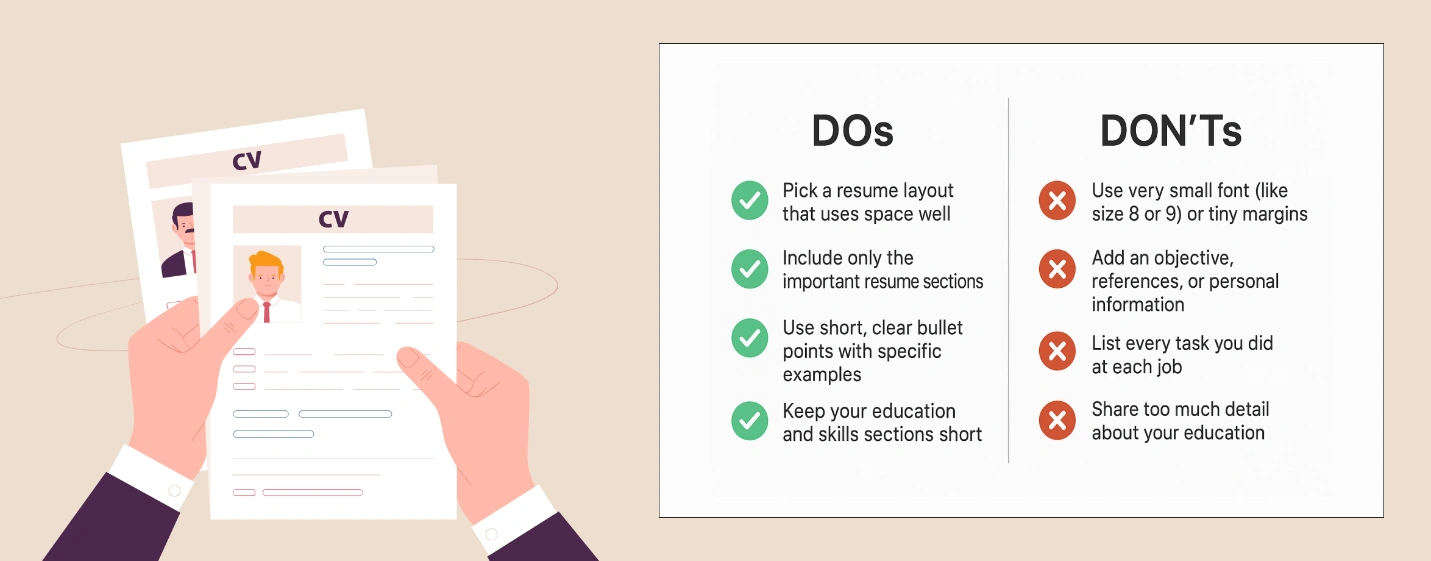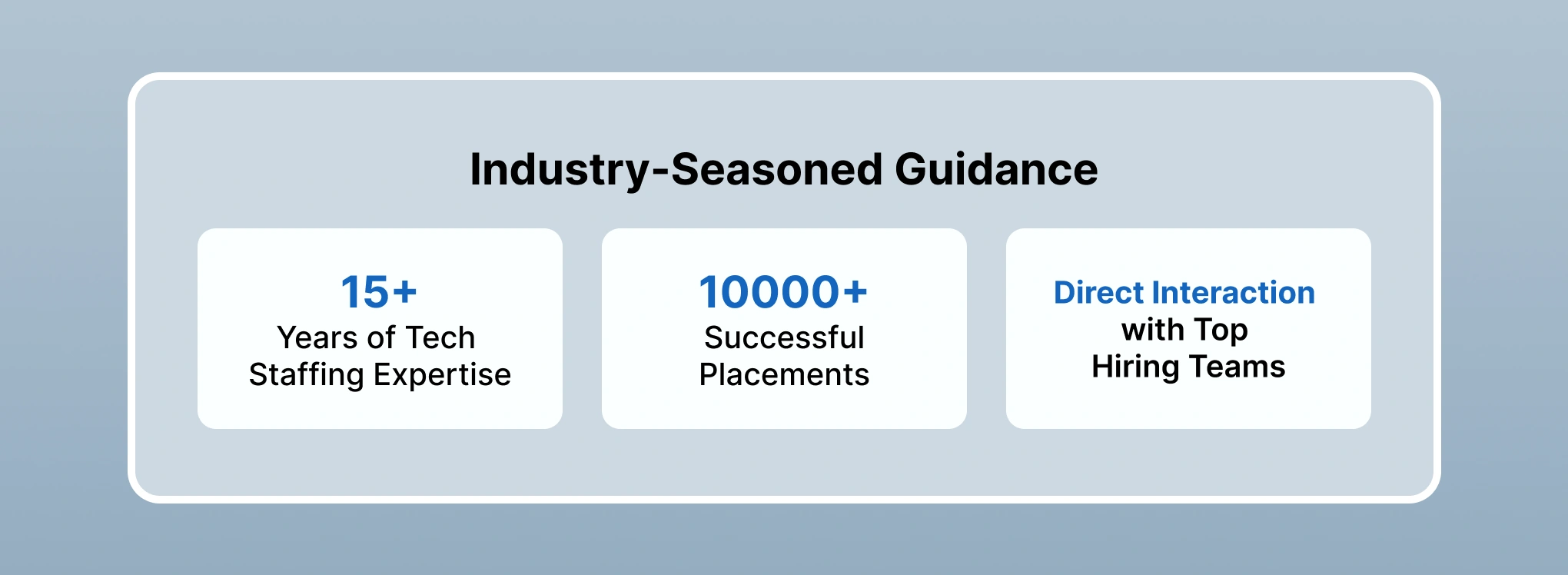
In the competitive realm of software engineering and data science, the advice to “keep your resume to one page” often echoes through campus career centers, generic online articles, and well-meaning friends. For entry-level roles outside of tech, this rule can make sense—recruiters skim hundreds of applications in minutes. In the tech industry, however, where hiring managers evaluate deep technical skills, project complexity, and domain expertise, artificially constraining yourself to one page can do more harm than good.
1. How the One-Page Resume Rule Took Hold
- College career counselors, aiming for brevity, popularized a one-page guideline to help students distill their experiences into a concise format.
- Mainstream media and “resume experts” lacking industry context reinforced the myth in blog posts and career-advice columns.
- Friends and family, applying non-tech hiring practices, often urge candidates to trim every detail without understanding what technical recruiters truly value.
- Online resume templates marketed as “proven” often omit sections critical for tech roles: detailed project descriptions, technologies used, and quantitative impact.
Over time, this well-intentioned counsel snowballed into an almost dogmatic rule—despite tech employers seeking evidence of hands-on skills and measurable outcomes.
2. Why One Page Can Cripple Your Tech Application
- Insufficient Project Detail
Tech roles demand context: the code you wrote, the frameworks you mastered, and performance benchmarks achieved. Squeezing this into one page often forces you to obscure or omit key accomplishments. - Weak Technical Footprint
Listing “Python” or “JavaScript” without elaborating on the libraries, versions, or scale of your systems leaves a hiring manager guessing at your true proficiency. - Lack of Quantifiable Metrics
Page limits lead to vague statements like “Assisted with backend development.” Recruiters look for metrics—“Reduced API response time by 40%” or “Processed 1M+ daily events,” details that rarely fit in a cramped layout. - Poor ATS Compatibility
Automated resume-screening tools often rely on keyword density. A one-page template optimized for human skimming might not include enough searchable terms to pass an Applicant Tracking System. - Missed Storytelling Opportunities
A compelling narrative—how you overcame a technical hurdle, optimized processes, or led a project—gets squeezed out, diluting the emotional and intellectual imprint of your candidacy.
When you follow the one-page dogma, you trade depth for brevity—and in tech, depth is everything.
3. The True Value of a Longer, Structured Resume
Tech resumes aren’t term papers; they should be readable. But readability and length aren’t mutually exclusive. A two-page or even tri-fold resume structured with clear headings, bullet lists, and sections allows you to:
- Showcase Stack Proficiency:
Dedicate a section to “Technical Skills” listing languages, frameworks, databases, and cloud platforms—with proficiency ratings or years of experience for each. - Highlight Key Projects:
For each major project, include problem statements, your architectural design, technologies used, and performance outcomes. A multi-page layout makes room for screenshots or links to GitHub repos. - Detail Certifications and Training:
In-demand roles often require certifications (e.g., AWS Solutions Architect, Oracle Certified Java Professional). A separate section ensures these credentials get noticed. - Include Publications and Presentations:
Workshops, conference talks, blog articles, or open-source contributions demonstrate thought leadership and community engagement—assets that rarely fit on one page.
Ultimately, a longer resume—when organized well—acts as a portfolio summary, giving hiring managers confidence that you’re capable of tackling their toughest challenges.
4. Example Comparison: Junior vs. Experienced Candidate Resumes
Below is a simplified illustration of how two tech resumes might differ in length and depth.
4.1 Junior Developer Resume (One Page)
| Name | Contact |
| John Doe | john@example.com |
Education
- B.S. Computer Science, XYZ University
Technical Skills
- Python, Java; SQL; HTML, CSS
Projects
- Chat App: Built a real-time chat application using Flask and Socket.IO.
- ToDo List: Created a CRUD app with React and Firebase.
Work Experience
- Intern, StartUp Co. (3 months): Assisted with front-end bug fixes.
Why it falls short: Lacks metrics, minimal skill detail, no discussion of obstacles overcome or scale.
4.2 Experienced Engineer Resume (Two Pages)
Name Contact LinkedIn GitHub
Summary
Detail-oriented backend engineer with 5+ years building microservices architectures, optimizing database performance, and deploying cloud-native solutions.
Technical Skills
- Languages: Java (8 yrs), Python (5 yrs), Go (2 yrs)
- Frameworks: Spring Boot, Django, Gin
- Databases: MySQL, PostgreSQL, Redis
- Cloud: AWS (EC2, Lambda, RDS), Docker, Kubernetes
Professional Experience
Senior Software Engineer, TechCorp
Jan 2022–Present
- Architected and deployed a Kubernetes-based microservices platform that scaled to 200K concurrent users, reducing infrastructure costs by 25%.
- Led a 4-person team in refactoring legacy monolith into decoupled services, cutting release cycles from 2 weeks to 3 days.
- Implemented CI/CD pipelines with Jenkins and Terraform, achieving zero-downtime deployments.
Software Engineer, DataPulse
Aug 2018–Dec 2021
- Built ETL pipelines ingesting 5M+ records daily using Python, Apache Airflow, and AWS S3.
- Optimized SQL queries to reduce report generation time from 15 minutes to 90 seconds.
- Mentored 6 junior engineers on best practices in unit testing and code reviews.
Education & Certifications
- M.S. Computer Science, ABC University
- AWS Solutions Architect Associate; Oracle Certified Java Professional
Open Source & Publications
- Contributor, Apache Kafka
- Speaker, PyCon 2023: “Scaling Real-Time Data Pipelines”
Why it succeeds: Provides rich detail, metrics, leadership highlights, and thought leadership—none of which would fit succinctly on one page.
5. How the Myth Persists Outside Tech Circles
- College Counselors: Many focus on general business or liberal-arts roles, where a one-page life story is prized over technical depth.
- Online Resume Gurus: Writers without domain expertise often repurpose the same templates across industries, ignoring how tech hiring differs.
- Friends and Family: Advice comes from their experiences—retail, finance, or creative fields—where skills are less quantifiable.
- Social Media and Forums: Viral infographics and TikTok videos celebrate minimalism without explaining the stakes in technical interviews.
These well-meaning voices lack firsthand knowledge of technical recruiting, where parsing code samples, evaluating system design experience, and understanding algorithmic complexity require more space than a single sheet can offer. Relying on generic advice risks under-representing your full capabilities.
6. Why You Need Industry-Seasoned Guidance
To craft a resume that resonates with hiring managers at Google, Amazon, Meta, or emerging tech startups, you need advice rooted in real-world placement success:
- 15+ Years of Tech Expertise:
Organizations like SynergisticIT have matched tech talent with roles across Fortune 500 companies and high-growth startups, learning what each client truly values in a resume. - 10,000+ Successful Placements:
Having placed over ten thousand candidates, SynergisticIT understands the nuances of candidate evaluation, from ATS parsing to live technical interviews. - Direct Interaction with Top Hiring Teams:
Continuous feedback loops with recruiters and engineering managers ensure that resume templates evolve alongside market demands—incorporating emerging tech like microservices, cloud-native development, and machine learning pipelines.
Generic resume advice won’t suffice for a field that changes by the month. Seek mentors and organizations with proven track records in your target industry.
7. SynergisticIT’s Job Placement Program: Building a Resume That Stands Out
At SynergisticIT, resume development is integral to our comprehensive job placement program. We guide you through every element:
- Skill Inventory & Gap Analysis:
We audit your technical proficiencies, certifications, and project portfolio to identify strengths and areas for expansion. - Role-Specific Tailoring:
Each resume draft targets a specific role—backend engineer, data scientist, DevOps specialist—aligning your summary, skills, and project details with the job description. - Quantitative Impact Statements:
We convert vague bullet points into data-driven achievements: “Improved query performance by 75%,” “Served 1M+ API requests daily,” and so on. - ATS Optimization:
Through strategic keyword placement and clean formatting, we ensure your resume sails through automated filters and lands in the hands of real recruiters.
- Iterative Feedback Cycles:
You’ll receive actionable feedback from senior IT professionals and hiring managers, refining clarity, formatting, and technical accuracy until your resume shines.
This process doesn’t just tick formatting boxes—it equips you to confidently speak to every line on your resume during live interviews.
8. SynergisticIT Program Tracks and Resources
8.1 Core Job Placement Program
Our flagship offering combines hands-on training with career support:
- 5–7 hours of live, instructor-led sessions daily over 5–7 months
- Small cohorts for personalized mentorship
- Enterprise-level capstone projects mirroring real client deliverables
- Comprehensive interview readiness: mock coding rounds, system design, and behavioral coaching
- Active résumé marketing to 24,000+ verified tech companies
- 12 months of post-placement support until you secure and settle into a role
- Proven placement rate of 91.5% with salaries ranging from $90K–$150K
8.2 Java & Full-Stack Development Track
Designed for aspiring software engineers to master both backend and frontend technologies:
- Core & advanced Java concepts (multithreading, collections, JVM tuning)
- Spring Boot, Hibernate, and enterprise microservices
- MERN stack: MongoDB, Express.js, React, Node.js
- AWS cloud fundamentals and deployment pipelines
- Real-world enterprise projects and certification prep (Java SE, AWS)
- Dedicated resume and interview coaching tailored to Java roles
8.3 Data Science & AI Track
For candidates pursuing analytics, machine learning, and AI engineering roles:
-
- Python ecosystem: NumPy, Pandas, SciKit-Learn, TensorFlow
- Data modeling, feature engineering, and visualization best practices
- Building and deploying ML pipelines on AWS (SageMaker, Lambda, ECS)
- Capstone projects in predictive analytics, NLP, and deep learning
- Interview prep with real questions drawn from past client assessments
9. SynergisticIT in the Press and Community
- USA Today Feature:
“How SynergisticIT Is Redefining Tech Talent Sourcing” explores our impact on shrinking skill gaps and ramp-up times for employers. (Link: USA Today Article about How SynergisticIT is Changing How Tech Companies Source Talent) - Interview Question Repository:
Access 5,000+ vetted questions across algorithms, system design, and behavioral rounds to simulate real interview conditions. - Event Videos & Webinars:
Our YouTube channel hosts panel discussions with tech leaders, mock interviews, and workshop recordings—equipping you to handle every interview stage. (Link: Synergisticit Tech Industry Interaction Videos at OCW, Oracle Java One, Gartner Summit and other Videos) - Career Growth Blog:
Articles on topics like “Crafting Impactful Project Descriptions” and “System Design Interview Mastery” keep you informed on hiring trends and best practices. (Link: Job Hunting Techniques)
Together, these resources form a 360° support ecosystem, turning resume builders into confident tech professionals.
10. Conclusion: Ditch the One-Page Constraint, Embrace Depth
The one-page resume myth persists because it feels tidy and familiar. In tech, however, tidy often equals superficial. Real hiring managers crave evidence of hands-on achievements, mastery of complex toolchains, and the ability to articulate technical decisions.
By expanding your resume thoughtfully—dedicating space to key projects, metrics, and technology stacks—you prove not just what you know, but what you can do. And by partnering with seasoned industry experts like SynergisticIT, you gain the insider perspective and tailored feedback needed to transform a simple document into a powerful narrative of your technical journey.
Ready to break free from the one-page fallacy? Explore SynergisticIT’s programs, leverage our resources, and build a resume that truly reflects your capabilities—and secures the interviews you deserve.






